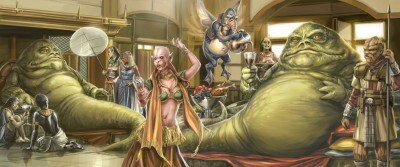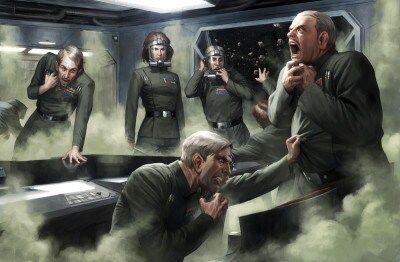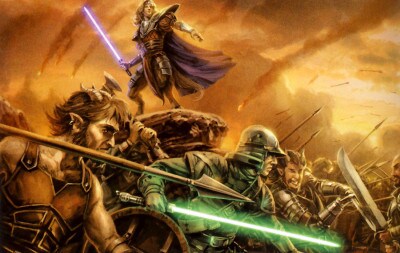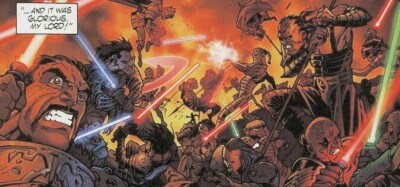Read a previously unpublished section from the hit book exclusively on the Star Wars blog.
Welcome to the fifth of 12 articles revealing - for the first time ever -- material cut from The Essential Guide to Warfare before its April 2012 publication. Each section will be preceded by brief comments discussing why the material wound up on the cutting-room floor.
DEATH ON THE RIM
Jason Fry: I really liked this next bit -- it’s been a mission of mine to make the Hutts truly monstrous instead of just comic relief. Mission accomplished, but I suspect what I really liked was goofing on the opening crawl of a rather familiar movie and incorporating a nod to another sci-fi classic. Very meta, but a rule of editing is “kill your darlings” and the manuscript was way too long...so bye-bye, darling. Still, wouldn’t this make a fun pulpy novel?
Erich Schoeneweiss: YES! I’m all for making the Hutts as monstrous as possible, and the piece below is inventive and fun. It’s a sidebar story though, and as the editor I have to keep the pace of the book moving along. One of the struggles I had -- first with pace and later with the design and layout -- was the number of sidebars in the book. Too many fun little pieces like this can quickly overwhelm a chapter and before you know it there are more sidebars in the chapter than chapter text. Fun as this was, it was a cut I agree with.
From the Proceedings of the Obroa-Skai Conference on Popular Entertainment, 6 ABY:
A long time ago, in a sector far, far away....
A vast sea of stars serves as the backdrop for the main title. War drums echo through the heavens as a rollup slowly crawls into infinity.
It is the final centuries of the Kymoodon Era. Brave Republic colonists are pushing beyond the galactic frontier, discovering new worlds where families can become farmers and homesteaders, building new lives for themselves far from the overcrowded city-worlds of the ancient Core.
But these intrepid colonists have no idea that other minds -- intellects vast, cruel and unsympathetic -- regard their worlds with envious eyes and slowly and surely are drawing plans against them. For the settlers have intruded on the domain of the Hutts, the scourge of the galactic edge.
On the small green world of Parcovey Minor, dozens of families have banded together to clear land for a nerf ranch, unaware that the Hutts have decided to make their colony an object lesson for any Republic citizen who would dare trespass on their domain….
Remarks of Thunys Albegron, Academician of Popular Studies
That, of course, was from True Tales of the Ancient Republic -- specifically, it’s the beginning of Episode XXIV: Death on the Rim. A great holodrama, even if it is 120 years old!
It would have been a cruel revelation for the boys and girls of a century ago to learn that the intrepid Sector Ranger Novan Nune almost certainly never existed -- much less followed the colonists kidnapped on Parcovey Minor to the dreaded arenas of Affavan, deep in Hutt Space, fought as a gladiator to win their freedom, and then returned to destroy the Hutt kajidic that had ravaged their world.
I know, I know! I want it to be true too!
But while the star of True Tales of the Ancient Republic and other decicred-dreadfuls may not have been a historical personage, the threats faced in the Kymoodon Era by Republic colonists were far from imaginary. And the assault on Parcovey Minor? That was a real event.
We know that from the discovery last year of fragmentary records in a Kymoodon-era government archive on Belasco. The record in question is a report prepared as background for a public advisory against colonization to rimward. We have no idea if the advisory was ever issued, but the report is fascinating, though it makes for grim reading. It details Hutt-backed assaults on five different worlds beyond what was then the frontier: Lexrul, Drogheda, Hathrox, Imram...and Parcovey Minor.
Those killed in such raids were the lucky ones. Most of the Belascoan men were condemned to brief, hellish lives as miners, engine tenders or serfs, while others were surgically altered and sent into clan battles as cyborg berserkers -- such a ceremonial battle was held on Lexrul, witnessed by a handful of colonists who escaped the raiders. Women who met the Hutts’ fickle standards of beauty might qualify as cupbearers or other decorative objects, at least until they offended or bored their masters. From Farm-Wife to Warrior is a contemporary account that I, for one, find credible. As for the children, the Hutts regarded slaves who couldn’t work as bad investments. I’ll leave it at that. We know of periodic emissaries from Belasco and other outlying Republic worlds to Hutt Space, but we have no credible evidence that any captured colonists were ransomed: To the Hutts, the colonization of their outlying domains was an act of war, and prisoners of that war would not be returned.
From the looks on your faces I’d advise against perusing the Belascoan Archive Report -- my summary of it is, if anything, too gentle. But there were the occasional triumphs amid terror -- and Parcovey Minor was one of them.
According to the Archive Report, a captured Jilruan pirate told the authorities on Belasco of the planned raid on Parcovey Minor. The Belasco Free Volunteers rushed to the colony’s defense and were hiding on several ranches when a barque filled with Klatooinian and Weequay raiders attacked. The Hutts’ brigands were all killed or captured, and revealed under interrogation that they served the Utoradii kajidic. Several dozen militia members and colonists took the captured ships to Affavan, where the slaves from Parcovey Minor were to be sorted and auctioned off, or disposed of at a parlay-feast between clans Utoradii and Vijilakii. Instead of terrified slaves, the assembled Hutts found themselves face to face with Belasco Volunteers who were heavily armed and seeking vengeance.
So no, Novan Nune never faced Huska the Hutt in single combat. But there really was a tale of triumph involving Parcovey Minor, Republic colonists, and some very surprised Hutts getting what they deserved. And given the terrors those brave settlers faced, it’s no exaggeration to call them heroes.
WORLD AT WAR: IRMENU
Jason Fry: The outline for Warfare included many write-ups of planets, but by the midpoint of the project I realized I’d been feeling my way into the book by replicating aspects of The Essential Atlas, and few of those write-ups made sense in the new book. (In the end, only two made it.) Irmenu was invented by Karen Traviss and had always intrigued me, so it was a fun exercise in world-building, and I can see ideas that would resurface in my own series, The Jupiter Pirates. Regardless, I think you’ll agree this didn’t belong in the book.
Erich Schoeneweiss: This piece, as well written as it is, demonstrates something I brought up in a previous post: Is it Star Wars enough? Until you get to the mentions of Vau, Daala, and the Mandalorians at the end this could have been about a planet from any sci-fi or space-fantasy series. That doesn’t mean it’s not interesting; but, when we’re over our word count and Jason and I are forced to cut material, a piece that doesn’t feel like Star Wars is an easier cut than one that does.
Irmenu is a small blue gem of a world tucked within the fringes of the Crombach Nebula. A single continental shelf stretches across half of the planet and is mostly covered with shallow seas, with its highest points reaching above the water to form island archipelagos ranging from sandy spits of land to crags of rock that soar hundreds of meters into the air, topped by forests and meadowlands. As Irmenu’s lone moon is large and follows an eccentric orbit, its tidal effects are both dramatic and complex. Away from the continental shelf, Irmenu’s oceans are storm-wracked and deep, sundered by abyssal trenches that run like scars across its crust.
Irmenu is one of the galaxy’s many lost colonies, and the circumstances of its founding are obscured by myth. A human population of perhaps 5 million occupies its many kingdoms, holds and crofts. Irmenu society is complex, a tangled web of feudal obligations woven atop a strict caste system. The Irmenu aristocracy consists of petty kings, dukes, counts, marquises, barons and cavaliers who have near-absolute dominion over commoners bound to them by ancient blood oaths. These aristocrats were once thralls of the Irmenu emperors, but their mad rule was overthrown centuries before the Galactic Empire, and the Irmenu imperial palace still lies in ruins. Outside of this rigid social structure sits the hierarchical priesthood of the Imperius, and the planet’s outcasts and excommunicates, many of whom live as pirates. These outlaws are simultaneously loathed as threats to the peace and envied for their freedom; many of Irmenu’s best-loved heroes had to become outlaws to best their enemies.
The Irmenu are superb sailors, taught from birth to understand the workings of winds and tides and to map the shallow seas around their home islands. Vendettas and wars of conquest are common enough that they’re practically sport, and every Irmenu lord expects his sons to prove their worth as seafarers and captains, able to lead ships effectively against pirates and rival lords. These feuds are kept in check by the Imperius, which wields the threat of spiritual censure, up to and including excommunication. The Imperius also patrols the seas, rescuing sailors in distress and battling pirates; tours of duty in Irmenu’s imperial navy are a religious obligation for members of the aristocracy, and sons who won’t inherit wealth or a title can find honor in the service.
Irmenu was rediscovered by the galaxy several centuries ago, and maintains contact via a single spaceport run by the Imperius. Many on the planet now sport blasters, communicators and other galactic technology -- incongruous sights aboard wooden-hulled caravels and galleons flying family banners. Ties between Irmenu and the galaxy have grown stronger, but both the Imperius and the Irmenu themselves remain ambivalent about such contact.
One benefit of contact, however, is that Irmenu who run afoul of their society’s mores can be exiled to other worlds instead of to inhospitable islands. Tales told by these exiles have made Irmenu an object of curiosity in the wider galaxy.
Notable Irmenu exiles include Walon Vau and Natasi Daala. Vau was the son of an admiral in the Irmenu imperial navy and in line to become the count of Gesl, but his domineering father refused him entry into the navy. Vau then fell in love with a princess from a neighboring province, but the match was refused by his father and hers, and the couple’s star-crossed rebellion ended with her captivity in an Imperius convent and Vau’s temporary exile. Leaving Irmenu, Vau became a Mandalorian, for which he was disowned by his family. He later became a member of the Cuy’val Dar, the secretive group recruited by Jango Fett to train units of clone commandos.
Daala grew up on Botajef and rose through the ranks of the Empire, but it wasn’t until her career as a Deep Core warlord that she discovered she was an Irmenu princess from a family whose holdings had been overrun and seized by rivals. The rest of Daala’s family was put to death, but a younger son of the victorious family took pity on the baby and smuggled her offworld, leaving her as a foundling at a Botajef orphanage.
NIGHTFALL ON RUUSAN
Jason Fry: I thought this was one of my “with” author’s nicer pieces of work, and I’m really happy to get to showcase it here. Honestly, it probably got cut because all the dialogue made it a very cost-effective subtraction. But enough of my yapping. Paul?
Paul Urquhart: The Battle of Ruusan is supposed to be a big date in Star Wars history, the equivalent of Gettysburg or Waterloo. The trouble is, everything obvious about Ruusan has been said already -- so I wanted to approach the story from a new angle and create some characters whose attitudes didn’t necessarily run in the directions the reader might expect. I also took the opportunity to explore an idea I feel is slightly underused: when Jedi knighthood becomes hereditary, an ancestral lightsaber might end up in the hands of someone who isn’t very good at using the Force.
Erich Schoeneweiss: It was pieces like this that proved very difficult for me. The Essential Guides are meant to be nonfiction books set within a fictional universe. The reality is it’s all fiction, but I strive to maintain the feel of a nonfiction book in these guides to the galaxy far far away. What was happening in The Essential Guide to Warfare was that Jason and Paul were writing short stories for some of the sidebars. My concern was that if there were too many of these, the book would start to feel more like an anthology than a nonfiction reference book. There were cases in which these shorts really added a nice flavor to the book and new insights into what Jason and Paul were writing about in the main body text. “Clone Trooper Falls in a Hole…” on page 80 is a perfect example: It’s a first-person account of a clone trooper’s experience during the Battle of Geonosis, and enhanced the entire chapter. “Nightfall on Ruusan” is a good story and solid writing, but Jason had already written about the Battle of Ruusan and the consequences to the galaxy in the text. So in our constant struggle with too much of a good thing this was one of the good things that had to be cut. I’m happy for Paul that you all get to read it now.
From “I, Corellian: Ruusan and Reformation”
I found myself staring into gray infinity. Eventually I realized I was looking up into the sky, lying flat on my back between the rain and the mud.
Someone was watching me. I turned my head and looked at her.
The girl was sitting cross-legged on the hood of a crashed command skimmer, sheathed in black armor, tight-fitting and glossy with rain. She had a long polearm held casually across her lap, a lanvarok with a wicked bardiche blade.
Her hair hung in dark braids around her cheeks. Her bare shoulders were tan from outdoor living. Her eyes, when they found my gaze, were ebony, flecked with gold.
“You’re still alive,” she smiled, as if it was funny.
Now I remembered. I’d been her prisoner. My hands were still tied. Groaning, I sat up, and looked around.
The battlefield was empty. The knights and lords were all gone, leaving just the rain and mud—and a few survivors abandoned even by the dead. The broken hulks of armored vehicles still rested where they’d sunk into the mire, big guns pointing at the ground. And here and there, I could see slanted lances, damp, tattered pennons lifting in the wind.
But that was all.
The Republic cleaned the wreckage up afterwards, and carved a big memorial out of the cliff face in the Valley – a clumsy statement, a way for the real victors to impose the wrong meaning on the war. That evening, the wreckage looked beautiful.
Hauling myself up to my feet -- painfully -- I looked at her.
“Githany was right,” the girl said, talking as much to the wind as to me. “She said Bane had kriffed Kaan’s head, tricked him into this stupidity.”
“Who’s left?” I asked. It came out as a whisper.
“My lords are all gone,” she said, not meeting my eyes. She held a tarnished Jedi comlink in her hand—my comlink. My lightsaber was on her hip. “Your Lord Farfalla seems to be in charge. He was far enough from the thought bomb, with his retinue. They say Lord Berethon’s channel is still transmitting, but he’s not answering”
“Farfalla?” I sighed, but the Force already told the truth – even to me. I looked around the battlefield and frowned. “What a waste.”
“You think?” She gave me an ambiguous look.
“More than you could know,” I replied.
She shivered slightly, but it was just the cold wind, a sign that night was coming.
“What now?” she asked.
“Let’s look for some way out of this mudpit.”
“You’re the slave here, Jai,” she reminded me. I shrugged my bound hands and started to walk. She could probably beat me in a straight fight, but I wasn’t in any mood for fighting, and I didn’t think she was either.
She hopped off her perch, hurrying to keep up.
“Don’t do that, slave,” she snapped. “It makes you look like you have some sort of plan.”
“What makes you think I don’t?” I asked.
“Jedi plans?” she asked, a wide sweep of her polearm taking in the ruin around us.
“Sith plans,” I said, and for a moment I felt some of the dangerous old fire.
She frowned for a moment. “You Jedi all just walked into the trap,” she said. “At least we did something with our deaths.”
“I’m still here,” I said. “So are you.”
She frowned again, and this time she kept quiet. I’d seen it a few times before, and I would see it a lot more—the mild confusion of a Sith soldier no longer in thrall to battle meditation.
I sometimes wonder if Jedi aren’t much different. We use battle meditation, too, but we assume we have a special exemption where delusions are concerned, because we’re on the right side.
She leaned on her polearm, watching me. “So where are we going? You want to find Lord Berethon?”
“The Lord Peregrine?” I asked her, in surprise. “You’ve heard of him?”
“Yeah, I hear he’s not a very good Jedi. You seemed to like him better than Farfalla, and I approve of that. I know Gith wanted him to join us.”
I laughed. “I tell you what—if I get you to Lord Berethon, you agree to release me and come under his protection.”
She tilted her head and looked at me, shifting her weight against the weapon. “You think he’d do that?”
“Yeah,” I said. “I think he would.”
“OK.” She shrugged, half-believing, and we walked on in silence. Overhead, the gray sky grew darker.
“Have you ever heard of Thon, the Master of Ambria?” I asked, as the rain eased.
“Should I have? I was in the battle there, last year.”
“He was a Jedi Master, three thousand years ago. He taught that the connection between light and dark was just the Force flowing, no different than the simple stuff about levitating rocks -- something basic, true, and interesting.”
“What happened to him?”
“You’ve seen Lake Natth, right? Thon created that, as a work of art.”
She looked at me, disbelieving. “But it’s a dark-side focus….”
“Thon thought it looked pretty in the mountains, apparently. And then there are the Miraluka. They worship Light and Dark together, believe them to be inseparable, like lovers. There are a lot of great Miraluka Jedi.”
Her eyes narrowed. “Do you believe that, Jai boy? About Light and Dark?”
“Nope. Not in a doctrinal way, anyway.” Near the horizon the setting sun had broken through the clouds. “I think that looks pretty, though.”
She gave me a sideways glance. “Maybe the Masters all just read the doctrines the wrong way, then?”
I couldn’t tell if she was teasing or not.
We walked on, as the stars came out overhead, turning the night to cool silver and shadow. I remember thinking that it was beautiful, and that her armor and the bare skin of her shoulders glinted like the steel and silk discarded around us. But I kept silent, and tried not to look at her too much.
“Do you have a name, Jai boy?” she asked eventually. Her smile hinted she was either starting to like me or planning to kill me. I couldn’t tell which. I wondered if she could.
I laughed, then stopped and looked at her.
“Cut my bonds and I’ll tell you,” I said. “I’m not going to run. Where would I run to?”
She looked at me doubtfully for a moment. Then the polearm flashed, and I was free. I rubbed my wrists, grimacing, then slowly looked up and held her gaze. She blinked back.
“Sorry,” I said with my best grin. “I’m Lord Berethon.”
It didn’t sound nearly as impressive out loud as it had in my head.
She looked disbelieving for a moment, then she laughed. Really laughed.
“You’re the Lord Peregrine…?! Oh, fierfek….”
I nodded. “I’m the King of Corellia. I was never much good as a Jedi, though.”
“I noticed.”
“I think I might try being king again.”
“You’d have made a worse Sith,” she said.
“Maybe. Come on. Let’s see if we can find a way off this rock.”
“I have your comlink,” she reminded me, holding out the battered handset. “Don’t you have a fleet in orbit, or something?”
“Oh. Yes, I do. It’s been a hard day.”
Her look grew softer as I took the comlink. If it had still been day, I could have seen the color of her eyes.
“Just remember, Your Kingship—you promised to take care of me.”
I murmured something in agreement. “Falcon? You didn’t hear any of that, right?”
Star Wars: The Essential Guide to Warfare is the definitive guide to the ultimate intergalactic battlefield. Packed with original full-color artwork, it includes facts, figures, and fascinating backstories of major clashes and combatants in the vast Star Wars universe.





